Related Research Articles
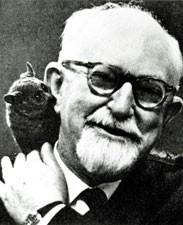
George Gaylord Simpson was an American paleontologist. Simpson was perhaps the most influential paleontologist of the twentieth century, and a major participant in the modern synthesis, contributing Tempo and Mode in Evolution (1944), The Meaning of Evolution (1949) and The Major Features of Evolution (1953). He was an expert on extinct mammals and their intercontinental migrations. Simpson was extraordinarily knowledgeable about Mesozoic fossil mammals and fossil mammals of North and South America. He anticipated such concepts as punctuated equilibrium and dispelled the myth that the evolution of the horse was a linear process culminating in the modern Equus caballus. He coined the word hypodigm in 1940, and published extensively on the taxonomy of fossil and extant mammals. Simpson was influentially, and incorrectly, opposed to Alfred Wegener's theory of continental drift, but accepted the theory of plate tectonics when the evidence became conclusive.
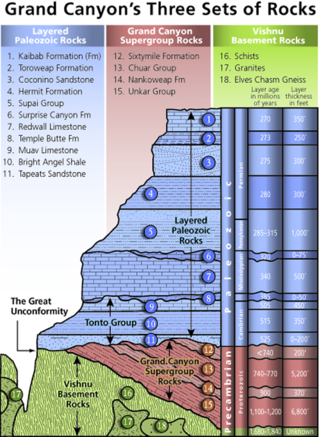
Of the many unconformities (gaps) observed in geological strata, the term Great Unconformity is frequently applied to either the unconformity observed by James Hutton in 1787 at Siccar Point in Scotland, or that observed by John Wesley Powell in the Grand Canyon in 1869. Both instances are exceptional examples of where the contacts between sedimentary strata and either sedimentary or crystalline strata of greatly different ages, origins, and structure represent periods of geologic time sufficiently long to raise great mountains and then erode them away.
Sir Nicholas John Shackleton was an English geologist and paleoclimatologist who specialised in the Quaternary Period. He was the son of the distinguished field geologist Robert Millner Shackleton and great-nephew of the explorer Ernest Shackleton.
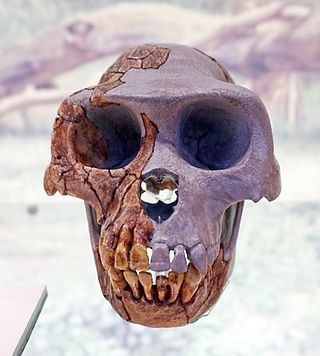
Ardipithecus ramidus is a species of australopithecine from the Afar region of Early Pliocene Ethiopia 4.4 million years ago (mya). A. ramidus, unlike modern hominids, has adaptations for both walking on two legs (bipedality) and life in the trees (arboreality). However, it would not have been as efficient at bipedality as humans, nor at arboreality as non-human great apes. Its discovery, along with Miocene apes, has reworked academic understanding of the chimpanzee–human last common ancestor from appearing much like modern-day chimpanzees, orangutans and gorillas to being a creature without a modern anatomical cognate.
Thure E. Cerling is a Distinguished Professor of Geology and Geophysics and a Distinguished Professor of Biology at the University of Utah. Cerling is a leading expert in the evolution of modern landscapes including modern mammals and their associated grassland ecologies and stable isotope analyses of the atmosphere. Cerling lives in Salt Lake City, Utah.
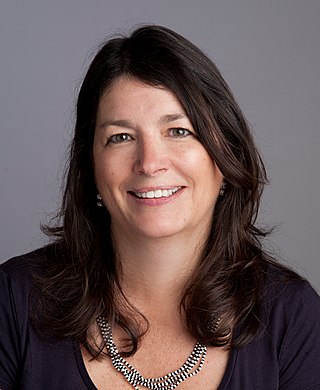
Maureen E. "Mo" Raymo is an American paleoclimatologist and marine geologist. She is the Co-Founding Dean of the Columbia Climate School, Director of the Lamont–Doherty Earth Observatory of Columbia University, the G. Unger Vetlesen Professor of Earth & Environmental Sciences, and Director of the Lamont–Doherty Core Repository at the Lamont–Doherty Earth Observatory of Columbia University. She is the first female climate scientist and first female scientist to head the institution.
Salinas is a lake event in the Salar de Uyuni, Bolivia.
Sajsi is the name of an ancient lake in the Andes
Pliopapio is an extinct genus of Old World monkey known from the latest part of the Miocene to the early Pliocene Epochs from the Afar Region of Ethiopia. It was first described based on a very large series of fossils from the site of Aramis in the Middle Awash, which has been dated by 40Ar/39Ar to 4.4 million years old. It has since been found from similarly aged sediments at Gona, approximately 75 km to the North. Additional fossils from the Middle Awash extend its known time range back to at least 5.3 million years ago. There is only one known species, Pliopapio alemui.
Gona is a paleoanthropological research area in Ethiopia's Afar Region. Gona is primarily known for its archaeological sites and discoveries of hominin fossils from the Late Miocene, Early Pliocene and Early Pleistocene. Fossils of Ardipithecus and Homo erectus were discovered there. Two of the most significant finds are an Ardipithecus ramidus postcranial skeleton and an essentially complete Homo erectus pelvis. Historically, Gona had the oldest documented Oldowan artifact assemblages. Archaeologists have since found older examples of the Oldowan at other sites. Still, Gona's Oldowan assemblages have been essential to the archaeological understanding of the Oldowan. Gona's Acheulean archaeological sites have helped us understand the beginnings of the Acheulean Industry.
Hendratta Ali is a geoscientist who does work in hydrology, aqueous geochemistry, exploration geology and equity geoscience. Her home institution is the Department of Geosciences at Fort Hays State University. She was awarded the 2021 Geological Society of America Randolph Bromery award and Fort Hays State University President’s Distinguished Scholar Award. Ali is a native of Cameroon.
Celina A. Suarez is an American geologist. She is known for her research on using trace element and stable isotope geochemistry of fossil vertebrates and invertebrates to understand paleoecology, paleoclimatology, and taphonomy of ancient terrestrial ecosystems. She is an associate profession in the Department of Geosciences at the University of Arkansas. The dinosaur Geminiraptor suarezarum is named after Suarez and her twin sister, Marnia Suarez, co-discovers of the site on which it was found.
Carmala Nina Garzione is an American geologist who is Professor of Geosciences and Dean of the College of Science at the University of Arizona. Previously, she was Associate Provost for Faculty Affairs at the Rochester Institute of Technology, and prior to that she was a professor at the University of Rochester. She was awarded the 2009 Blavatnik Awards for Young Scientists.
Joan Esterle is an American-Australian geologist who is an emeritus professor at school of Earth and Environmental Sciences from The University of Queensland, Australia and the chair of its Coal Geoscience Program.
Delores Marie Robinson is an American geologist and tectonicist who is a professor and department chair at the University of Alabama. Her research considers how orogenic systems evolve from porto-magmatic arcs, with a particular focus on Western Nepal, India, Bhutan and Southern Tibet.
Ariel Anbar is an isotope geochemist and President's Professor at Arizona State University. He has published over 180 refereed papers on topics ranging from the origins of Earth's atmosphere to detecting life on other worlds to diagnosing human disease.
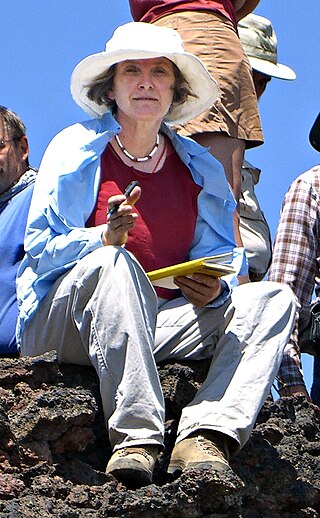
Anita Lizzie Grunder is geologist known for her research on volcanic rocks and defining changes in volcanism over geologic eras. She is an elected fellow of the Geological Society of America.
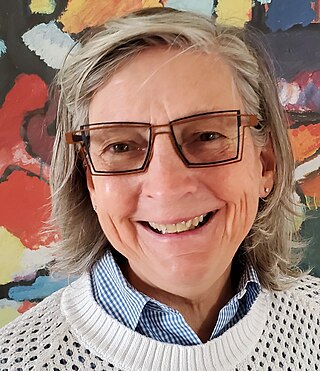
Holly Jayne Stein is an American geologist who is a senior research scientist and a professor at Colorado State University. She established the AIRIE Program and has led the center since 1995. Her research focuses on the development of the rhenium-osmium (Re-Os) geochronometers. In 2015, she was elected Geochemistry Fellow of the European Association of Geochemistry.

Laura J. Crossey is an American hydrologist and geochemist and Distinguished Professor of Earth and Planetary Sciences at the University of New Mexico (UNM). Crossey is part of UNM's Sustainable Water Resources Grand Challenge team, which studies water and climate in New Mexico and other arid regions. She has studied springs and groundwater in areas including the Western Desert of Egypt, Australia's Great Artesian Basin, Tibet, the Middle Rio Grande Basin and the Grand Canyon.
John Williams Valley is an American geochemist and petrologist. He is an expert on stable isotope geochemistry, especially as applied to understanding the evolution of the Earth's crust.
References
- 1 2 3 Rech, Jason. "2018 Arthur Day Medal, Presented to Jay Quade". Geological Society of America.
- ↑ "The Geology of Just About Everything: Tales of a Field Geologist - Jay Quade". YouTube . August 12, 2022.
- 1 2 3 "Jay Quade, CV" (PDF). Department of Geosciences, University of Arizona.
- ↑ "Jay Quade (home page)". Department of Geosciences, University of Arizona.
- ↑ Semaw, Sileshi; Rogers, Michael J.; Quade, Jay; Renne, Paul R.; Butler, Robert F.; Dominguez-Rodrigo, Manuel; Stout, Dietrich; Hart, William S.; Pickering, Travis; Simpson, Scott W. (2003). "2.6-Million-year-old stone tools and associated bones from OGS-6 and OGS-7, Gona, Afar, Ethiopia". Journal of Human Evolution. 45 (2): 169–177. doi:10.1016/S0047-2484(03)00093-9. PMID 14529651.
- ↑ Stiner, Mary C.; Buitenhuis, Hijlke; Duru, Güneş; Kuhn, Steven L.; Mentzer, Susan M.; Munro, Natalie D.; Pöllath, Nadja; Quade, Jay; Tsartsidou, Georgia; Özbaşaran, Mihriban (2014). "A forager–herder trade-off, from broad-spectrum hunting to sheep management at Aşıklı Höyük, Turkey". Proceedings of the National Academy of Sciences. 111 (23): 8404–8409. Bibcode:2014PNAS..111.8404S. doi: 10.1073/pnas.1322723111 . PMC 4060719 . PMID 24778242.
- ↑ English, Nathan B.; Betancourt, Julio L.; Dean, Jeffrey S.; Quade, Jay (2001). "Strontium isotopes reveal distant sources of architectural timber in Chaco Canyon, New Mexico". Proceedings of the National Academy of Sciences. 98 (21): 11891–11896. Bibcode:2001PNAS...9811891E. doi: 10.1073/pnas.211305498 . PMC 59738 . PMID 11572943.
- ↑ Diamond, Jared (21 March 2013). "Chapter 4. The Ancient Ones: The Anasazi and Their Neighbors". Collapse: How Societies Choose to Fail or Survive. Penguin UK. ISBN 9780141976969.
- ↑ "Invitation for the Special Lecture on A 25,000 year megaflood record from the central Andes by Prof. Jay Quade, Department Geosciences, University of Arizona" (PDF). Geological Society of India. April 3, 2023.
- ↑ "Farouk El-Baz Award". Geological Society of America.